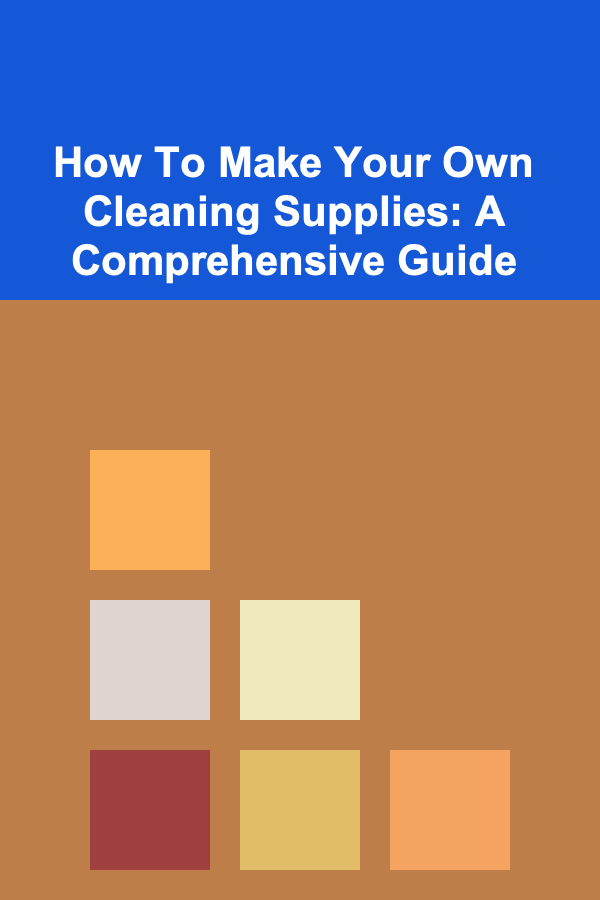
How To Make Your Own Cleaning Supplies: A Comprehensive Guide
ebook include PDF & Audio bundle (Micro Guide)
$12.99$10.99
Limited Time Offer! Order within the next:

In an era of increased environmental awareness and growing concerns about the chemicals we bring into our homes, making your own cleaning supplies has become an increasingly popular and appealing option. Not only can you control the ingredients, eliminating harsh chemicals and potential allergens, but you can also save money and reduce plastic waste. This comprehensive guide will walk you through the benefits of DIY cleaning, the essential ingredients, a variety of recipes for different cleaning needs, safety precautions, and tips for successful homemade cleaning.
Why Make Your Own Cleaning Supplies?
The reasons for embracing DIY cleaning are multifaceted, ranging from personal health and environmental concerns to economic and practical advantages.
- Healthier Home Environment: Commercial cleaning products often contain volatile organic compounds (VOCs), which can contribute to indoor air pollution and trigger respiratory problems, allergies, and skin irritations. By making your own cleaning supplies, you can avoid these harmful chemicals and create a healthier living space for yourself and your family.
- Reduced Environmental Impact: The production and disposal of conventional cleaning products contribute to pollution and waste. Homemade cleaners typically use biodegradable ingredients and can be stored in reusable containers, significantly reducing your environmental footprint.
- Cost Savings: Many common household ingredients, such as vinegar, baking soda, and lemon juice, can be used to create effective cleaning solutions at a fraction of the cost of commercial products. Over time, the savings can be substantial.
- Customization: DIY cleaning allows you to tailor your cleaning solutions to your specific needs and preferences. You can adjust the strength, scent, and ingredients to create products that are perfectly suited to your home and lifestyle. If you are sensitive to certain smells, you can avoid them. If you prefer a stronger cleaning agent, you can adjust the ratios accordingly.
- Reduced Plastic Waste: Commercial cleaning products are typically packaged in single-use plastic bottles, which contribute to plastic pollution. By making your own cleaning supplies, you can reuse existing spray bottles and containers, reducing your reliance on plastic and minimizing waste.
- Empowerment and Control: Knowing exactly what goes into your cleaning products gives you a sense of control over your home environment. You can be confident that you are using safe and effective solutions without relying on vague ingredient lists or marketing claims.
Essential Ingredients for DIY Cleaning
A surprising number of common household items can be transformed into powerful and effective cleaning agents. Here's a rundown of the essential ingredients you'll need to get started:
- White Vinegar: A natural disinfectant and deodorizer, vinegar is effective at cutting through grease, removing hard water stains, and killing mold and mildew. Its acidity makes it a versatile cleaner for various surfaces.
- Baking Soda: A mild abrasive and deodorizer, baking soda is excellent for scrubbing surfaces, absorbing odors, and unclogging drains. Its alkaline nature helps to neutralize acids.
- Lemon Juice: A natural antiseptic and degreaser, lemon juice adds a fresh scent and can help to remove stains and brighten surfaces. The citric acid acts as a natural cleaning agent.
- Castile Soap: A gentle and biodegradable soap made from vegetable oils, castile soap is a versatile cleaner for various surfaces and can be used as a base for many DIY cleaning recipes. Dr. Bronner's is a popular and widely available brand.
- Essential Oils: In addition to providing a pleasant scent, certain essential oils have antibacterial, antifungal, and antiviral properties. Popular choices for cleaning include tea tree, lavender, lemon, eucalyptus, and peppermint. Always dilute essential oils properly before use.
- Washing Soda (Sodium Carbonate): A stronger cleaner than baking soda, washing soda is effective at removing tough stains, softening water, and boosting the cleaning power of other ingredients. It is more alkaline than baking soda and should be handled with care.
- Borax (Sodium Borate): A natural mineral with disinfecting and deodorizing properties, borax can be used to clean and whiten laundry, remove stains, and kill mold and mildew. However, it has been the subject of some controversy regarding its safety, so use with caution and research thoroughly before using.
- Hydrogen Peroxide: A natural disinfectant and bleaching agent, hydrogen peroxide is effective at killing germs and removing stains. Use 3% hydrogen peroxide for most cleaning applications.
- Water: Distilled water is ideal for cleaning solutions, as it is free of minerals and impurities that can interfere with the cleaning process.
Essential Equipment for DIY Cleaning
Having the right equipment on hand will make the process of making and using your own cleaning supplies much easier and more efficient.
- Spray Bottles: Reusable spray bottles are essential for storing and dispensing your homemade cleaning solutions. Label each bottle clearly with the name of the product and the date it was made. Consider using dark-colored bottles for solutions containing essential oils, as they can degrade in sunlight.
- Glass Jars: Glass jars are ideal for storing dry ingredients, such as baking soda and washing soda, and for making concentrated cleaning solutions.
- Measuring Cups and Spoons: Accurate measuring is essential for creating effective cleaning solutions.
- Funnel: A funnel makes it easier to transfer liquids and powders into bottles and jars without spilling.
- Mixing Bowls: Use mixing bowls to combine ingredients for your cleaning recipes.
- Cleaning Cloths and Sponges: Reusable cleaning cloths and sponges are more environmentally friendly than disposable paper towels. Microfiber cloths are particularly effective at cleaning various surfaces.
- Gloves: Protect your hands from harsh ingredients by wearing gloves when making and using cleaning solutions.
- Labels: Clearly label all your homemade cleaning supplies with the name of the product, the ingredients, and the date it was made. This will help you avoid confusion and ensure that you are using the right product for the job.
DIY Cleaning Recipes
Now that you have the essential ingredients and equipment, let's explore some popular and effective DIY cleaning recipes:
All-Purpose Cleaner
This versatile cleaner can be used on a variety of surfaces, including countertops, floors, and appliances.
- 1 cup white vinegar
- 1 cup water
- 10-20 drops essential oil (lemon, lavender, or tea tree)
Instructions: Combine all ingredients in a spray bottle and shake well. Spray on the surface to be cleaned and wipe with a clean cloth.
Glass and Window Cleaner
This simple cleaner will leave your windows and mirrors streak-free.
- 1/4 cup white vinegar
- 2 cups water
- Optional: a few drops of essential oil for scent
Instructions: Combine all ingredients in a spray bottle and shake well. Spray on the glass or mirror and wipe with a clean microfiber cloth.
Toilet Bowl Cleaner
This cleaner will help to disinfect and deodorize your toilet bowl.
- 1/2 cup baking soda
- 1 cup white vinegar
- Optional: a few drops of tea tree essential oil
Instructions: Sprinkle baking soda into the toilet bowl, then pour in the vinegar. Let it fizz for a few minutes, then scrub with a toilet brush and flush.
Oven Cleaner
This natural oven cleaner is a safe and effective alternative to harsh chemical cleaners.
- 1/2 cup baking soda
- Water
- White vinegar (in a spray bottle)
Instructions: Make a paste of baking soda and water and spread it all over the inside of your oven, avoiding the heating elements. Let it sit overnight. The next day, spray the baking soda paste with vinegar and wipe clean with a damp cloth.
Drain Cleaner
This simple drain cleaner can help to unclog slow drains.
- 1/2 cup baking soda
- 1 cup white vinegar
- Boiling water
Instructions: Pour baking soda down the drain, followed by vinegar. Let it fizz for 30 minutes, then pour boiling water down the drain.
Laundry Detergent
This homemade laundry detergent is gentle on clothes and effective at cleaning.
- 1 cup washing soda
- 1 cup borax (optional)
- 1 bar castile soap, grated
- Optional: a few drops of essential oil for scent
Instructions: Combine all ingredients in a large bowl and mix well. Use 1-2 tablespoons per load of laundry.
Floor Cleaner
This cleaner is safe for most floor types (always test in an inconspicuous area first!).
- 1/4 cup white vinegar
- 1 gallon warm water
- Optional: a few drops of essential oil for scent
Instructions: Combine all ingredients in a bucket. Mop the floor with the solution. No rinsing required.
Furniture Polish
This polish will help to protect and shine your wooden furniture.
- 1/4 cup olive oil
- 1 tablespoon lemon juice
Instructions: Combine the olive oil and lemon juice in a small bowl. Apply a small amount of the mixture to a clean cloth and rub it into the furniture. Buff with a dry cloth.
Mold and Mildew Cleaner
This solution is effective for removing mold and mildew from surfaces.
- 1 part hydrogen peroxide (3%)
- 2 parts water
Instructions: Combine the hydrogen peroxide and water in a spray bottle. Spray the affected area and let it sit for 10 minutes. Scrub with a brush and rinse with water. Ensure proper ventilation during use. For stubborn mold, you can also use undiluted white vinegar, letting it sit for an hour before scrubbing and rinsing.
Safety Precautions
While DIY cleaning supplies are generally safer than commercial products, it's still important to take precautions to protect yourself and your family.
Important Safety Tips:
- Always label your cleaning supplies clearly. This will help you avoid confusion and ensure that you are using the right product for the job.
- Store cleaning supplies out of reach of children and pets. Even natural ingredients can be harmful if ingested.
- Never mix vinegar and bleach. This combination creates toxic chlorine gas, which can be fatal.
- Test cleaning solutions in an inconspicuous area before using them on a larger surface. This will help you to ensure that the solution doesn't damage or discolor the surface.
- Wear gloves when making and using cleaning solutions, especially if you have sensitive skin.
- Ensure proper ventilation when using cleaning supplies, especially those containing essential oils or vinegar.
- Be careful when using washing soda and borax, as they can be irritating to the skin and eyes.
- Research the safety of any new ingredients before using them in your cleaning supplies.
Tips for Successful Homemade Cleaning
Making your own cleaning supplies is a rewarding experience, but it takes a little bit of practice and experimentation to get it right. Here are some tips to help you succeed:
- Start with simple recipes and gradually work your way up to more complex formulas.
- Use high-quality ingredients for the best results.
- Adjust the recipes to suit your specific needs and preferences.
- Don't be afraid to experiment with different ingredients and combinations.
- Be patient and persistent. It may take a few tries to find the perfect cleaning solution for your home.
- Consider the surface you are cleaning. Some surfaces, like marble or granite, can be damaged by acidic cleaners like vinegar and lemon juice.
- Clean regularly to prevent dirt and grime from building up. This will make cleaning easier and more effective.
- Embrace the process! Making your own cleaning supplies can be a fun and empowering way to take control of your home environment.
Troubleshooting Common Issues
Even with the best recipes and intentions, sometimes things don't go as planned. Here are some common issues you might encounter and how to address them:
- Lingering Vinegar Smell: The strong smell of vinegar can be off-putting to some. Adding essential oils, particularly citrus scents, can help mask the odor. Proper ventilation is also key. The vinegar smell usually dissipates quickly after the surface dries.
- Streaky Windows: Using too much cleaner or not using a clean microfiber cloth can lead to streaks. Try diluting the cleaner further or using a fresh, dry cloth for the final wipe.
- Cloudy Residue: This can be caused by hard water interacting with soap. Use distilled water in your cleaning solutions. Rinsing surfaces after cleaning can also help.
- Essential Oil Separation: Essential oils are not water-soluble and can separate from the mixture over time. Shake the bottle well before each use. You can also add a small amount of a solubilizer, such as Polysorbate 20, to help keep the oils dispersed.
- Clogged Sprayers: Some homemade cleaners, particularly those containing baking soda or castile soap, can clog spray nozzles. Diluting the cleaner further or using a strainer when filling the bottle can help prevent clogs. Rinsing the sprayer with hot water after each use is also a good idea.
- Mold Reappearing: If mold keeps coming back, ensure you are thoroughly removing it and addressing the underlying moisture problem. Improve ventilation and consider using a stronger disinfectant like tea tree oil or grapefruit seed extract in your cleaning solution.
Beyond Cleaning: Other Uses for Common Ingredients
The beauty of these common cleaning ingredients is their versatility. They can be used for more than just cleaning your home. Here are some bonus uses:
- Baking Soda: Can be used as a natural toothpaste, to soothe insect bites, to deodorize your refrigerator, and to extinguish small grease fires (do not use water!).
- White Vinegar: Can be used as a fabric softener, to remove hard water deposits from showerheads, to kill weeds in your garden, and to tenderize meat.
- Lemon Juice: Can be used to lighten age spots, to brighten blonde hair, to prevent avocados from browning, and to make lemonade.
- Castile Soap: Can be used as shampoo, body wash, shaving cream, and pet shampoo.
- Essential Oils: Can be used in aromatherapy, massage oils, and homemade beauty products.
The Future of DIY Cleaning
As awareness of the environmental and health impacts of conventional cleaning products continues to grow, the DIY cleaning movement is poised to become even more popular. Innovation in sustainable packaging, the development of new and effective plant-based ingredients, and increased access to information will further empower individuals to create safe, effective, and eco-friendly cleaning solutions for their homes. Embrace the power of simple ingredients and join the growing community of DIY cleaners who are transforming the way we clean and care for our living spaces.
Disclaimer: The information provided in this guide is for informational purposes only and should not be considered medical or professional advice. Always test cleaning solutions in an inconspicuous area before using them on a larger surface. Use caution when handling ingredients and follow all safety precautions. The author and publisher are not responsible for any damages or injuries resulting from the use of this information.

How to Incorporate Minimalist Holiday Decor into Your Home
Read More
How to Organize Crafting Projects by Season or Holiday
Read More
How to Store Extra Hangers and Clothes Pins Efficiently
Read More
How To Understand the Concept of Wormholes
Read More
How to Build an Emergency Fund
Read More
How To Boost Your Bone Density
Read MoreOther Products

How to Incorporate Minimalist Holiday Decor into Your Home
Read More
How to Organize Crafting Projects by Season or Holiday
Read More
How to Store Extra Hangers and Clothes Pins Efficiently
Read More
How To Understand the Concept of Wormholes
Read More
How to Build an Emergency Fund
Read More